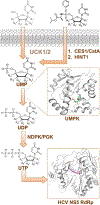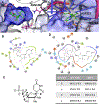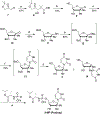In silico design of a novel nucleotide antiviral agent by free energy perturbation
- PMID: 35313085
- PMCID: PMC9175506
- DOI: 10.1111/cbdd.14042
In silico design of a novel nucleotide antiviral agent by free energy perturbation
Abstract
Nucleoside analogs are the backbone of antiviral therapies. Drugs from this class undergo processing by host or viral kinases to form the active nucleoside triphosphate species that selectively inhibits the viral polymerase. It is the central hypothesis that the nucleoside triphosphate analog must be a favorable substrate for the viral polymerase and the nucleoside precursor must be a satisfactory substrate for the host kinases to inhibit viral replication. Herein, free energy perturbation (FEP) was used to predict substrate affinity for both host and viral enzymes. Several uridine 5'-monophosphate prodrug analogs known to inhibit hepatitis C virus (HCV) were utilized in this study to validate the use of FEP. Binding free energies to the host monophosphate kinase and viral RNA-dependent RNA polymerase (RdRp) were calculated for methyl-substituted uridine analogs. The 2'-C-methyl-uridine and 4'-C-methyl-uridine scaffolds delivered favorable substrate binding to the host kinase and HCV RdRp that were consistent with results from cellular antiviral activity in support of our new approach. In a prospective evaluation, FEP results suggest that 2'-C-dimethyl-uridine scaffold delivered favorable monophosphate and triphosphate substrates for both host kinase and HCV RdRp, respectively. Novel 2'-C-dimethyl-uridine monophosphate prodrug was synthesized and exhibited sub-micromolar inhibition of HCV replication. Using this novel approach, we demonstrated for the first time that nucleoside analogs can be rationally designed that meet the multi-target requirements for antiviral activity.
Keywords: RNA-dependent RNA polymerase; alchemical free energy perturbation; flavivirus; nucleoside antiviral agents; structure-based drug design; viral polymerase.
© 2022 John Wiley & Sons A/S.
Figures




Similar articles
-
Nucleoside analog inhibitors of hepatitis C virus replication.Infect Disord Drug Targets. 2006 Mar;6(1):17-29. doi: 10.2174/187152606776056698. Infect Disord Drug Targets. 2006. PMID: 16787301 Review.
-
Anti-hepatitis C virus activity of novel beta-d-2'-C-methyl-4'-azido pyrimidine nucleoside phosphoramidate prodrugs.Antivir Chem Chemother. 2009 Oct 19;20(2):99-106. doi: 10.3851/IMP1400. Antivir Chem Chemother. 2009. PMID: 19843980 Free PMC article.
-
Progress in the development of anti-hepatitis C virus nucleoside and nucleotide prodrugs.Future Med Chem. 2012 Apr;4(5):625-50. doi: 10.4155/fmc.12.10. Future Med Chem. 2012. PMID: 22458682 Review.
-
Inhibition of hepatitis C virus replication by GS-6620, a potent C-nucleoside monophosphate prodrug.Antimicrob Agents Chemother. 2014;58(4):1930-42. doi: 10.1128/AAC.02351-13. Epub 2014 Jan 13. Antimicrob Agents Chemother. 2014. PMID: 24419349 Free PMC article.
-
Nucleoside, nucleotide, and non-nucleoside inhibitors of hepatitis C virus NS5B RNA-dependent RNA-polymerase.J Med Chem. 2012 Mar 22;55(6):2481-531. doi: 10.1021/jm201384j. Epub 2012 Jan 23. J Med Chem. 2012. PMID: 22185586 Review. No abstract available.
References
-
- Alexandre F-R, Badaroux E, Bilello JP, Bot S, Bouisset T, Brandt G, Cappelle S, Chapron C, Chaves D, & Convard T (2017). The discovery of idx21437: Design, synthesis and antiviral evaluation of 2′-α-chloro-2′-β-c-methyl branched uridine pronucleotides as potent liver-targeted hcv polymerase inhibitors. Bioorganic & medicinal chemistry letters, 27(18), 4323–4330. - PubMed
-
- Appleby TC, Perry JK, Murakami E, Barauskas O, Feng J, Cho A, Fox D, Wetmore DR, McGrath ME, & Ray AS (2015). Structural basis for rna replication by the hepatitis c virus polymerase. Science, 347(6223), 771–775. - PubMed
-
- Caglioti C, Lalle E, Castilletti C, Carletti F, Capobianchi MR, & Bordi L (2013). Chikungunya virus infection: An overview. New Microbiol, 36(3), 211–227. - PubMed
Publication types
MeSH terms
Substances
Grants and funding
LinkOut - more resources
Full Text Sources
Medical
Research Materials

